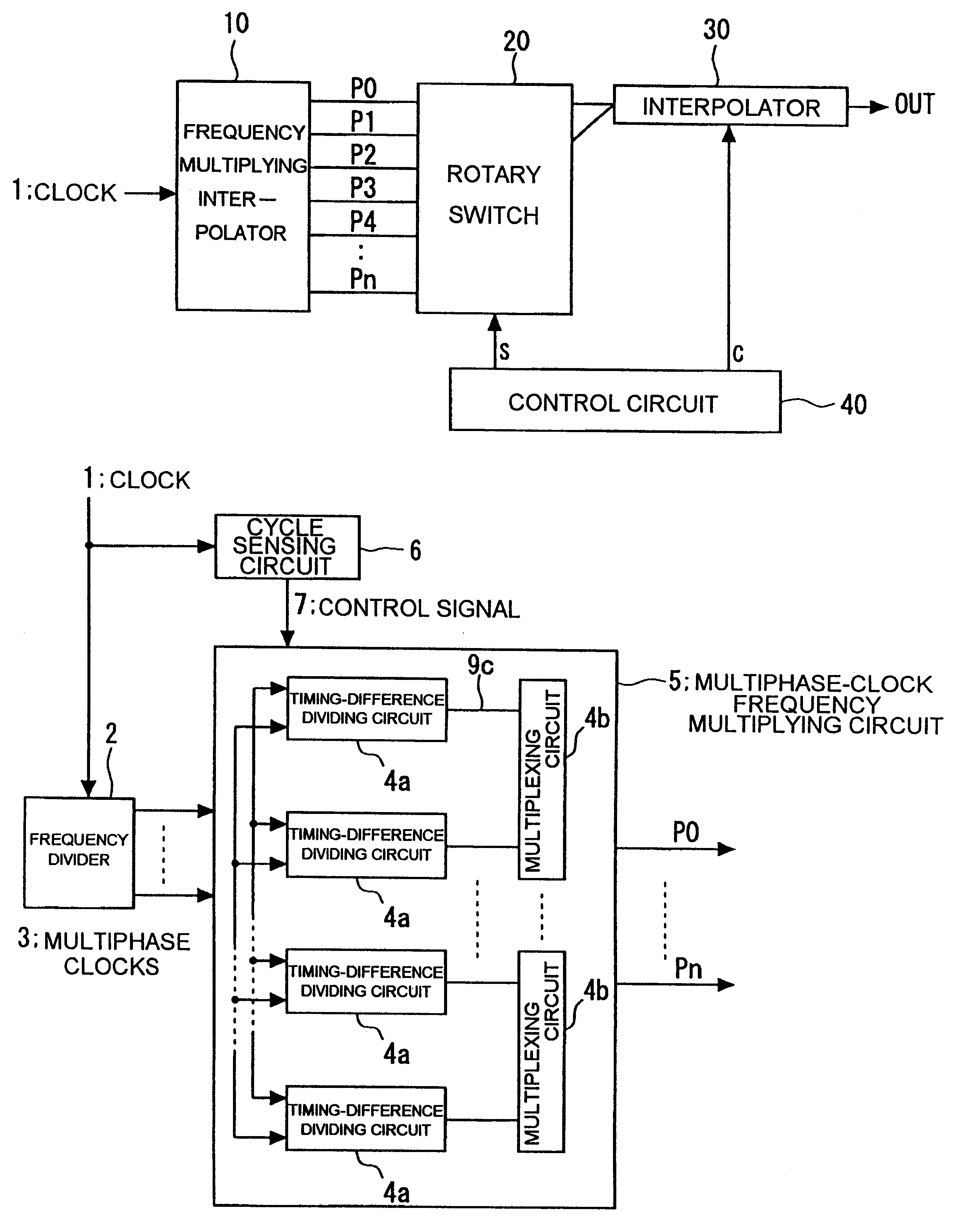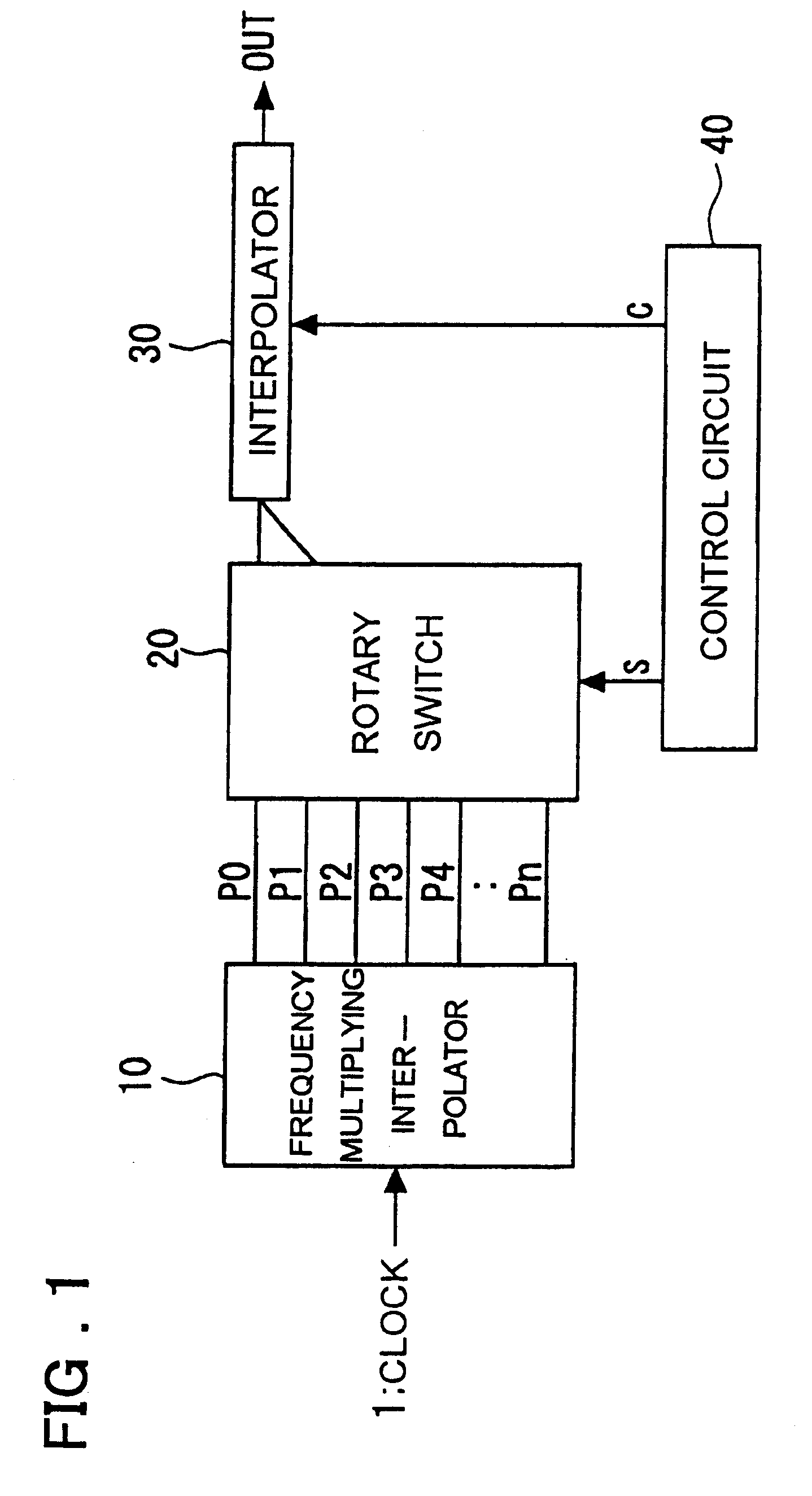Clock control circuit and clock control method
a clock control and clock technology, applied in the direction of generating/distributing signals, pulse techniques, oscillation generators, etc., to achieve the effect of uniform phase difference and greatly reduced jitter per frequency-multiplied clock
- Summary
- Abstract
- Description
- Claims
- Application Information
AI Technical Summary
Benefits of technology
Problems solved by technology
Method used
Image
Examples
second embodiment
FIG. 2 is a block diagram illustrating the structure of the present invention.
As shown in FIG. 2, this embodiment differs from the first embodiment in that there are provided a plurality of interpolators 300 to 301 each of which outputs a signal obtained by internally dividing a phase difference between two signals output from a switch 20', the outputs of the interpolators constituting frequency-multiplied clocks Q0 to Qn. In the second embodiment, the structures of the frequency multiplying interpolator 10 and of the individual interpolators 300 to 301 are identical with those of the frequency multiplying interpolator 10 and interpolator 30 described in connection with the first embodiment.
FIG. 3 is a block diagram showing an example of the structure of the switch 20' and of the arrangement of the plurality of interpolators 30 according to the second embodiment of the invention.
As shown in FIG. 3, the switch 20' has a selector switch 20'-1 to which odd-phase clocks among the multip...
first embodiment
In a manner similar to that of the control circuit 40 described in conjunction with the first embodiment, the control circuit 40' comprises a counter and a decoder circuit and outputs the control signal C to each interpolator 30. If it is necessary to advance or delay phase further in a case where the internal-division ratio of an interpolator 30 has attained an upper or lower limit, the control circuit 40' exercises control to change over the odd-phase clock, which is supplied to the interpolator 30 as the first input signal, to the immediately adjacent odd-phase clock on either side, and to change over the even-phase clock, which is supplied to the interpolator 30 as the second input signal, to the immediately adjacent even-phase clock on either side.
FIG. 14 is a diagram showing results obtained by investigating the operation of a clock control circuit according to an embodiment of the present invention. FIG. 14 depicts the results obtained by using a circuit simulator (SPICE 2) t...
third embodiment
a clock control circuit according to the present invention will now be described with reference to the drawings.
FIG. 15 is a block diagram illustrating the structure of a clock control circuit according to a third embodiment of the present invention.
As shown in FIG. 15, the clock control circuit of the third embodiment uses shift-register-type counters 170, 171 and has phase adjusting interpolators 130, 131 serving as the control cirrcuit 40 of the first embodiment. The interolator 130 is for finely adjusting the phase difference between input clocks to 0.degree., and the fine adjusting interpolator 131 outputs a clock signal obtained by shifting phase by an amount equivalent to any angle (offset).
More specifically, as shown in FIG. 15, a multiphase frequency multiplying circuit 110 to which the input clock 1 is input for generating multiphase frequency-divided clocks is constituted by, e.g., the frequency multiplying interpolator 10 described in the foregoing embodiments. The multi...
PUM
 Login to View More
Login to View More Abstract
Description
Claims
Application Information
 Login to View More
Login to View More - R&D
- Intellectual Property
- Life Sciences
- Materials
- Tech Scout
- Unparalleled Data Quality
- Higher Quality Content
- 60% Fewer Hallucinations
Browse by: Latest US Patents, China's latest patents, Technical Efficacy Thesaurus, Application Domain, Technology Topic, Popular Technical Reports.
© 2025 PatSnap. All rights reserved.Legal|Privacy policy|Modern Slavery Act Transparency Statement|Sitemap|About US| Contact US: help@patsnap.com



